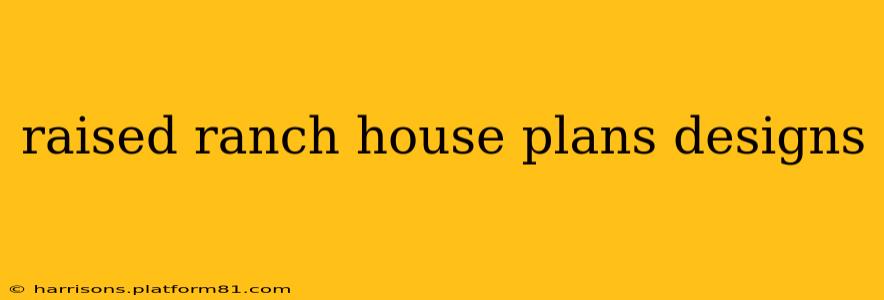The raised ranch, a classic American home style, offers a unique blend of functionality and aesthetic appeal. Its elevated design provides a practical layout and often incorporates stunning views. This guide delves into the various aspects of raised ranch house plans and designs, exploring their benefits, common features, and considerations for those planning to build one.
What are the Benefits of a Raised Ranch House?
Raised ranch homes offer several key advantages:
- Elevated Living: The raised foundation provides unobstructed views, especially desirable in hilly or wooded areas. This also often leads to better natural light.
- Walk-out Basement: A significant benefit is the potential for a walk-out basement, adding valuable living space and offering direct access to the backyard. This can be used as a guest suite, in-law apartment, recreation room, or home office.
- Single-Story Living (Main Level): The main living area is typically situated on a single level, making it ideal for families with young children or those seeking ease of accessibility as they age.
- Cost-Effective Build (Potentially): Depending on the size and complexity, raised ranches can sometimes be more cost-effective to construct than other styles with similar square footage. This is particularly true if you utilize the basement for additional living space rather than expanding the upper floor.
- Versatile Design: Raised ranch designs are incredibly adaptable, accommodating various architectural styles and personal preferences.
What are Common Features of Raised Ranch House Plans?
Several features define a typical raised ranch:
- Elevated Foundation: The defining feature, setting the main living space above ground level.
- Open Floor Plan (Often): Many modern raised ranch designs incorporate open-concept living spaces connecting the kitchen, dining, and living areas.
- Attached Garage: Most raised ranch homes feature an attached garage, providing convenient access and protection from the elements.
- Multiple Bedrooms & Bathrooms: Usually, 3-4 bedrooms and 2-3 bathrooms are accommodated within the layout.
- Large Windows: To maximize the views from the elevated position and provide ample natural light.
What are Different Styles of Raised Ranch Homes?
The beauty of raised ranch architecture lies in its adaptability. You can incorporate diverse stylistic elements, leading to unique homes:
- Modern Raised Ranch: Clean lines, large windows, open floor plans, and minimalist aesthetics are hallmarks of this contemporary approach.
- Traditional Raised Ranch: Characterized by classic elements such as gables, dormers, and more symmetrical facades.
- Rustic Raised Ranch: Embraces natural materials like wood and stone, often incorporating elements that complement a wooded or mountainous setting.
- Farmhouse Raised Ranch: Combines the practicality of the raised ranch with the charm of farmhouse aesthetics, using features such as wide porches and board-and-batten siding.
How Much Does it Cost to Build a Raised Ranch?
The cost of building a raised ranch varies significantly depending on several factors:
- Location: Land prices and construction costs differ greatly by region.
- Size: Larger homes naturally require more materials and labor.
- Finishes: High-end finishes will increase the overall cost.
- Customization: Extensive custom features and design changes add to the expense.
- Basement Finish: Finishing the basement significantly impacts the total cost.
It's essential to work with a builder to get an accurate estimate tailored to your specific plans and location.
What are Some Considerations When Designing a Raised Ranch?
Several aspects require careful planning:
- Accessibility: While the single-story main level is advantageous, consider accessibility features for future needs.
- Climate: Design choices should accommodate local climate conditions, including insulation, roofing, and window selection.
- Lot Size & Topography: The lot's size and slope significantly influence the design and placement of the home.
- Views: Maximize the benefits of the elevated position by strategically placing windows and decks.
- Energy Efficiency: Incorporate energy-efficient materials and features to reduce long-term operating costs.
What are the Disadvantages of a Raised Ranch?
While offering many benefits, raised ranches also have some potential drawbacks:
- Foundation Issues (Potentially): Proper foundation construction is critical to prevent future problems.
- Limited Storage (Sometimes): Depending on the design, storage space might be a concern.
- Stairs: The presence of stairs to access the basement or upper level may pose challenges for those with mobility issues.
Are Raised Ranches Good for Families?
Raised ranches can be excellent family homes, providing a single-story living space for ease of access and supervision, while the basement offers extra space for kids to play or have their own space as they get older.
Can a Raised Ranch Be Modern?
Absolutely! Modern raised ranch designs often incorporate clean lines, large windows, and open floor plans, creating a sleek and contemporary aesthetic.
This comprehensive guide provides a thorough overview of raised ranch house plans and designs, highlighting their benefits, common features, and considerations for building. Remember to consult with professionals – architects and builders – to ensure your project aligns perfectly with your vision and needs.
